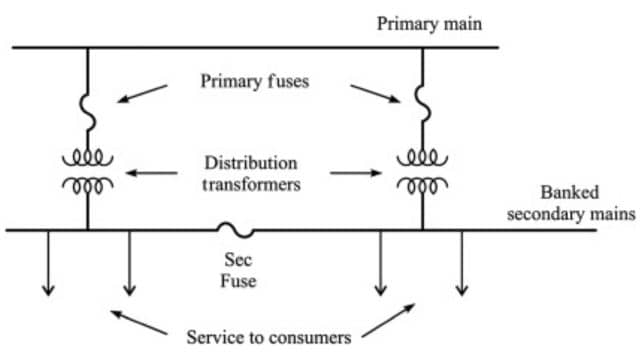
Table of Contents
Introduction
The distribution systems is like the delivery system for electricity in a local area. It’s the electrical setup between the substation (getting power from the main transmission) and the meters at homes or businesses.
Components of the Distribution System
- Distribution Sub-Station: A power hub moving electricity from big lines to neighbourhoods.
- Feeders: Electrical roads connecting the sub-station to areas, ensuring a steady current.
- Distribution Transformers: Lower voltage transformers are termed service transformers, with output voltages of 440V (3-phase) and 230V (1-phase in India).
- Distributor: Conductors with taps provide power to homes, but current varies along its length due to taps. The design considers voltage drop limits.
- Service Mains: Small cables linking distributors to individual meters at homes.

Classification of Distribution System
Based on Current Nature:
- DC Distribution System: Uses direct current.
- AC Distribution System: Uses alternating current.
Based on Construction Type:
- Overhead System: Cables are above ground.
- Underground System: Cables are below ground.
Based on the Connection Scheme:
- Radial System: Power flows in one direction.
- Ring Main System: Power can flow in multiple paths.
- Interconnected System: Multiple systems are connected for better reliability.
Types of AC Distribution System
1. Primary Distribution System
The primary distribution system is a section of the AC distribution system that works at slightly higher voltages than what we use in homes. The specific voltage chosen depends on how much power needs to be transferred and the distance to the substation. Common primary distribution voltages include 11 kV, 6.6 kV, and 3.3 kV. This distribution is typically done using a 3-phase, 3-wire system due to economic reasons.
2. Secondary Distribution System
The secondary distribution system is where consumers use electrical energy. In India, this involves voltages like 440V (3-phase) and 230V (1-phase) in a 3-phase 4-wire system. It’s the part where electricity is supplied to homes and businesses for daily use.

Requirements of a Distribution System
For a good distribution system:
- Stable Voltage: Keep voltage fluctuations at consumer points low, adhering to set limits (± 6% in India).
- On-Demand Power: Ensure electricity is available whenever consumers need it, in the required quantity.
- Reliability: Since many industries rely heavily on electric power, ensure a dependable and consistent service.
Advantages of Distributed System
- Inherently Distributed Applications: Apps in distributed systems are spread out.
- Geographically Shared Information: Info is shared among users across locations.
- Resource Sharing: Systems can share resources from distant places.
- Better Price Performance and Flexibility: More cost-effective with increased flexibility.
- Shorter Response Time and Higher Throughput: Faster responses and more data handled.
- Higher Reliability and Availability: More reliable, even if some parts fail.
- Extensibility: Systems can grow incrementally and extend to remote locations.
Disadvantages of Distributed System
- Lack of Relevant Software: Currently, there’s no ideal software for distributed systems.
- Security Concerns: Shared resources can lead to easy access to data, posing security issues.
- Networking Saturation Issues: Lag or saturation in the network can hinder data access.
- Complex Database Management: Databases in distributed systems are more complex compared to single-user systems.
- Network Overload Risk: If all nodes send data simultaneously, the network may get overloaded.
Applications Area of Distributed System
- Finance and Commerce: Amazon, eBay, Online Banking, and E-Commerce websites.
- Information Society: Search Engines, Wikipedia, Social Networking, and Cloud Computing.
- Cloud Technologies: AWS, Salesforce, Microsoft Azure, SAP.
- Entertainment: Online Gaming, Music, YouTube.
- Healthcare: Online patient records, Health Informatics.
- Education: E-learning.
- Transport and Logistics: GPS, Google Maps.
- Environment Management: Sensor technologies.
Challenges of Distributed Systems
- Network Latency:
- Issue: Delays in communication.
- Challenge: Affects system performance.
- Distributed Coordination:
- Issue: Coordinating nodes is tough.
- Challenge: Due to the system’s spread-out nature.
- Security:
- Issue: More susceptible to threats.
- Challenge: Due to the system being distributed.
- Data Consistency:
- Issue: Keeping data consistent is tough.
- Challenge: Across multiple nodes in the system.
Frequently Asked Questions (FAQs)
What is the distributed system?
A distributed system is like a team of computers or devices collaborating over a network. Each device handles specific tasks, working together to get a job done more efficiently than if a single device did it alone.
What is a distribution system service?
Distributed systems in business manage inventory, ensure timely deliveries, and operate conveniently for both businesses and customers. In supply chain management, they include storage facilities and transportation systems that handle orders and deliver goods to customers.
What is a distribution system design?
Designing a distribution system ideally means figuring out the most cost-effective network that can handle the needed two-way data transfer for the required number of endpoints while meeting performance goals.
What is an AC and DC distribution system?
The main difference between AC and DC power is that AC has a frequency, while DC does not. This frequency in AC makes it compatible with transformers, which are crucial for adjusting voltage levels during distribution.
Read Also:
- Transmission Line | Introduction, Classification, and Modelling
- Substation | Classification of Substations
- 10 Difference Between Indoor and Outdoor Substations
- Modern Grid | Characteristics and Functions
- High Voltage Direct Current (HVDC) Transmission






Leave a Reply